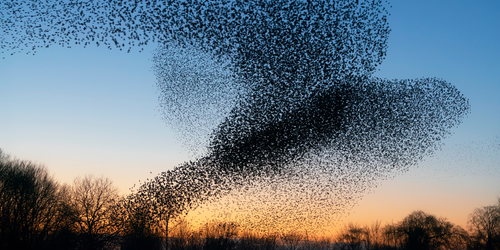“Dirt” Is No Barrier to Flocking
The onset of fall brings with it mesmerizing flocks of thousands of birds moving in unison through the evening sky. Similar behavior is seen in systems containing other types of self-propelled particles, such as schooling fish, swimming bacteria, and motile cancer cells. To date, researchers have mostly modeled systems where the media through which the flocking particles move are free of imperfections, leaving open the question of how disorder or “dirt” might change the collective behavior. Now John Toner from the University of Oregon and colleagues have shown that imperfections in the form of quenched disorder have no impact on the ability of flocking particles to move coherently [1, 2]. The researchers hope that their findings could be applied to understand the behavior of flocking cells inside the human body, which is filled with idealized dirt.
If a system contains quenched disorder, then at least one of the parameters defining its behavior is a random variable that doesn’t evolve with time—it is effectively frozen. Because of that, flocking particles moving through such a system have no impact on its disorder. But whether the disorder impacts the flocking behavior of the particles was, until now, unclear.
In their model, Toner and his colleagues considered “polar” active particles—particles that propel along a preferential direction—moving through fluids with quenched disorder. The model predicts that particle flocks form even in the presence of quenched disorder.
Quenched disorder is relevant to cancer cells, which can exhibit collective, flocking motion as they form tumors. The medium these tumors move through are typically filled with imperfections. “Since motion is important for life, it’s important to know whether that motion can be coherent in the presence of dirt,” Toner says. “The answer to that question was not known until we did this research.”
–Allison Gasparini
Allison Gasparini is a freelance science writer based in Santa Cruz, CA.
References
- L. Chen et al., “Packed swarms on dirt: Two-dimensional incompressible flocks with quenched and annealed disorder,” Phys. Rev. Lett. 129, 188004 (2022).
- L. Chen et al., “Hydrodynamic theory of two-dimensional incompressible polar active fluids with quenched and annealed disorder,” Phys. Rev. E 106, 044608 (2022).




